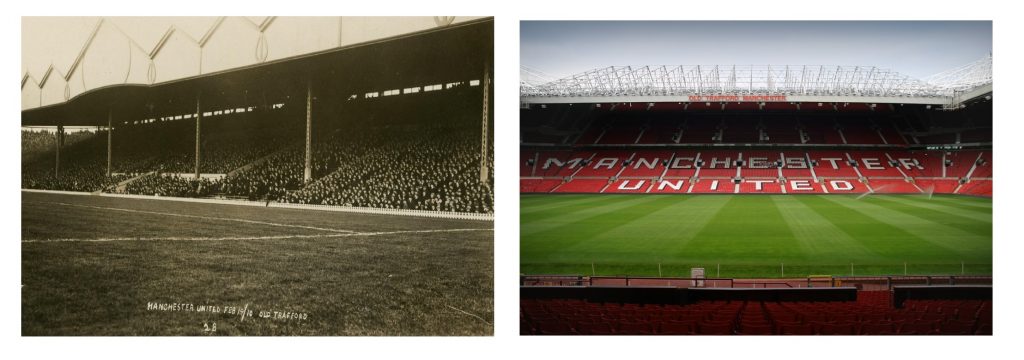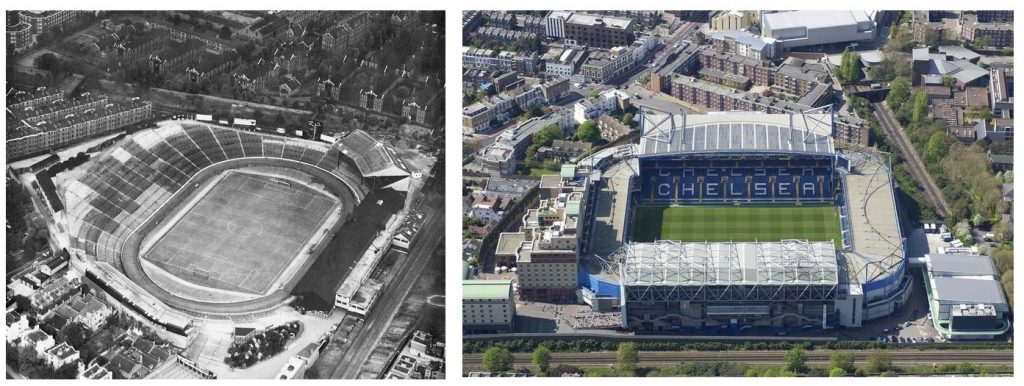The beautiful game of football has been around longer than any of us have been on this planet. And as the game has evolved over time, both through its status and through the overall interest in football, we’ve seen quite a change in the way in which spectators can watch the game. Specifically, when you look back through stadiums then and now, it’s just incomparable, with some of the most famous stadiums undergoing some seriously impressive changes. This is what we’ve covered right here, and some of the changes are quite staggering!
Stadiums then and now
Camp Nou

Having taken three years to build, and standing like a bit of a Gladiator arena, Camp Nou is undoubtedly one of the most impressive stadiums in Europe. The stadium was officially opened in 1957, and as it happens, the general style of the stadium hasn’t changed all that much. However, having undergone three separate renovations since it was first opened, Camp Nou has transformed into a very modern stadium, not to mention that it is now the largest in Europe in terms of its capacity – almost 100,000 spectators when full! It would seem that the club isn’t satisfied there either, as yet another renovation is underway which will increase the capacity to around 105,000.
Since Barcelona has also grown into one of the most prestigious clubs in the world, it’s no great surprise that when people look back through stadiums then and now, Camp Nou is always one that carries an extra special feeling. As you may already know, Camp Nou has hosted some truly awesome football games over the years too, including games in the 1982 World Cup and several high-profile Champions League games.
Old Trafford

The second ground on our journey through stadiums then and now is Old Trafford or the ‘Theatre of Dreams’ as it is now famously known. The stadium first opened its doors back in 1910, and as it happens, it has been Manchester United’s home ground since day one. The ground itself hasn’t actually changed drastically compared with other major European grounds, although changes such as the transformation of the seating plan, additional tiers, and the inclusion of the new roof are the most obvious ones. And if you like a bit of history – Old Trafford was actually shared between both Manchester United and Manchester City during World War Two, mainly due to bombings and stadium damage. While we weren’t around during those times, we can’t imagine that either team was happy about it!
These days, Old Trafford has a capacity of more than 74,000, making it the second-largest stadium in the UK after Wembley. It’s also a stadium that has played host to some of the greatest legends of the game, like Sir Alex Ferguson, Cristiano Ronaldo, and David Beckham.
St James’ Park

It’s perfectly normal that when browsing through stadiums then and now, visual changes to a grounds structure are notable, and usually, the changes make a stadium look more modern and more aesthetically pleasing. However, compared with the other stadiums on this list, we wouldn’t say that this is necessarily the case with St James’ Park. There have been all kinds of arguments and planning problems associated with the expansion of the stadium, and when you look at it today, things don’t quite seem to fit. Then again, this does provide the stadium with a nice bit of character, and we can’t take away from the fact that the stadium has stood the test of time – having been in the same spot since 1892. But even when it comes to football pitch sizes, there are some common standards that need to be met.
Back then, this area was basically just a muddy field with a one-tiered ground looping around the pitch. However, thanks to large investments over time, the ground has evolved into a multi-tier stadium, with floodlights, conference rooms, bars, and much more.
Stamford Bridge

Given that Stamford Bridge was constructed back in 1876, it goes without saying that this ground is shrouded in history. Of course, professional football wasn’t quite as popular back then as it is today, but since Chelsea FC was first established (1905), Stamford Bridge has been a bit of a temple for football fans in London. Although the stadium currently has a capacity of just over 40,000, there are some big plans to increase this to over 60,000 within a few short years – which would make Stamford Bridge even more impressive than it is today.
The general layout of the stadium and its seating was completely revolutionized in the 1990s too, mainly due to stadium disasters such as Hillsborough and the subsequent legal changes to spectators at professional football games. While this naturally decreased the number of spectators allowed at the games, Stamford Bridge has actually hosted over 82,000 spectators back in 1935 – and we can only imagine how the atmosphere must have been! Then again, safety precautions are necessary, and they are obviously one of the largest differences between stadiums then and now.
Santiago Bernabeu

Moving away from the UK now, we are heading back to Spain with the Santiago Bernabeu Stadium – the home of Real Madrid. This stadium was first built much more recently compared with some of the other grounds in the UK, as it first opened its doors back in 1947. It’s pretty crazy to think that when comparing stadiums then and now, some stadiums in the UK had already been open for more than 70 years at that point. Then again, it would seem that Spain has caught up, and some might say surpassed the quality of English football – especially Real Madrid!
Back in the 1950s, this stadium was actually referred to by locals as the Madrid Coliseum, and since it could contain around 125,000 spectators at the time, it was seriously impressive. But with that said, it didn’t have any of the impressive floodlights, tiers, and it certainly didn’t have the same vibe it has today. Despite the reduction in seating capacity, however, to the 81,044 we see today, the atmosphere has no doubt improved beyond belief – not to mention the following that Madrid clearly has!
Check out our collection of the most impressive abandoned football stadiums.
last update: January 2026